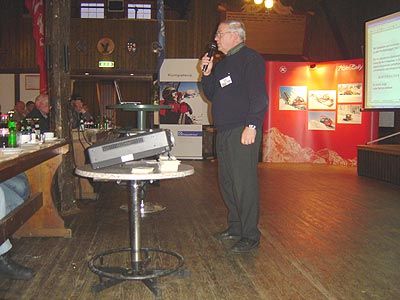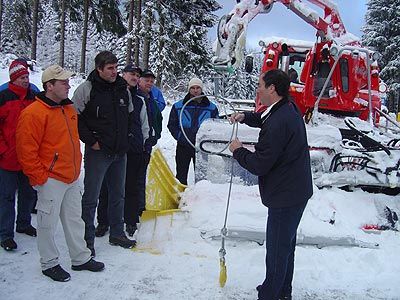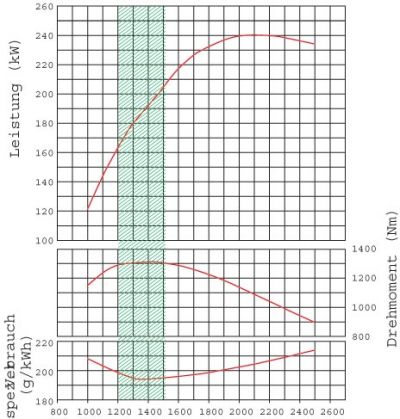
Karl Knab, Service Manager at Kässbohrer, gives valuable tips at the Technicians’ Day in Winterberg.
Save as you drive.
Valuable tips from Kässbohrer for economical, environmentally-aware deployment of PistenBully vehicles.
Laupheim, 19th November 2007. PistenBully vehicles are a joy to drive. Nevertheless, driving is, of course, a job of work for the driver and does inevitably involve the emission of a certain amount of pollutants. But it is possible to protect resources by driving economically and responsibly. Around 100 participants at the Technicians’ Day in Winterberg were given some useful practical advice for their day-to-day work.
It’s often the small things that matter. So Kässbohrer recommends that, whilst driving, you keep the torque to between 1200 and 1500 newtonmetres if at all possible. This is because, in this speed range, the engine’s specific fuel consumption is at its lowest – in other words, it is operating in the “green zone”. In addition to giving fuel-saving tips, Kässbohrer also provides comprehensive assistance to its customers on the sensible use of tracked vehicles in order to minimise effects such as air pollution, noise pollution, ground pollution and damage to vegetation.
The PistenBully has made Kässbohrer Geländefahrzeug AG the clear market leader worldwide in the field of slope and trail care. However, its proven “top-class service” isn’t just confined to the professional maintenance of vehicles and fast delivery of spare parts. Kässbohrer also gives just as much thought to the protection of the environment. For example, in the Engadine ski resort of St. Moritz, the slopes are already being prepared for the new season with zero-particulate vehicles. PistenBully vehicles feature diesel particulate filters made from sintered metal, a technology that was awarded the German Environment Prize back in 2003.
Admittedly though, five vehicles carrying out maintenance work on the slopes for one hour still cause considerably less harm to the environment than one hour’s worth of road traffic on a one kilometre stretch of motorway - using in this case around 36 percent less diesel fuel and emitting 36 percent fewer emissions. The PistenBully engines comply with EURO-MOT specifications. For indoor vehicles, Kässbohrer fits catalytic converters as standard. And it’s not just the innovative technical features that are helping to reduce air pollution. With its driver tips, Kässbohrer AG has established clear guidelines that are easy to implement. One example is to avoid warming up the engine while stationary. This is also quite unnecessary, because PistenBully engines have an electric pre-heater to heat the coolant. In addition, the engine should be switched off when the machine is stationary and carrying unnecessary loads should be avoided. But it doesn’t stop there. Optimum planning of vehicle use and a flexible deployment strategy (using accurate weather observations) will help just as much to reduce emissions as will a driver’s sound knowledge of the structure of the snow cover. Optimum tiller use and prompt preparation can also prolong the life of the slope.
Because of the difficult conditions in which they are used, PistenBully vehicles are exposed to high levels of load and do create a certain amount of noise. Even though the tracked vehicle, producing noise levels of 85 decibels, is still discernibly quieter than the 110 decibel noise created by an average disco, here too Kässbohrer AG has some valuable tips on how to reduce noise pollution to a minimum. Unnecessary noise can be avoided by considerate driving and using the lowest possible engine speed when working. It is also important that no modifications are made to the vehicle without the approval of the manufacturer.
Kässbohrer also has a whole host of suggestions ready when it comes to ground pollution. The vehicles should only be cleaned and re-fuelled on sealed platforms with oil traps – and of course, bio-degradable detergents should be the preferred choice. Regular inspection of the vehicles and observance of maintenance specifications are particularly important in this context. For example, pollution of the ground with hydraulic fluid can be avoided by regularly checking the hydraulic hoses. Using the vehicle for other purposes and overloading it can also harm the ground too and for this reason should be avoided at all costs. When it comes to disposal, “doing things properly” is the motto to follow here. Oils, greases and filters should be put with special waste, steel and aluminium parts should be cleaned before being disposed of and plastic and rubber parts should under no circumstances be burned.
Thanks to its tracks, a PistenBully only exerts a ground pressure of 0.044 kilograms per square metre. To put that figure into perspective, a cow, with its four hooves, exerts a pressure of 6 kilograms per square metre on the ground. But just like a living creature, a vehicle does leave its mark in the natural environment. However, it should not result in damage to vegetation; here too, the behaviour of the driver is a decisive factor. Kässbohrer advises exercising caution when there is insufficient snow depth or the terrain is soft. Because it’s not only excellently prepared slopes, but a pristine natural environment too that makes for happy skiers.

Karl Knab, Service Manager at Kässbohrer, gives valuable tips at the
Technicians’ Day in Winterberg.

The winch cable can be easily and
quickly checked for any rope torque.

The engine’s specific fuel
consumption is at its lowest in the speed range between 1200 and 1500
newtonmetres (OM 926 LA PistenBully 300 with 330 HP).